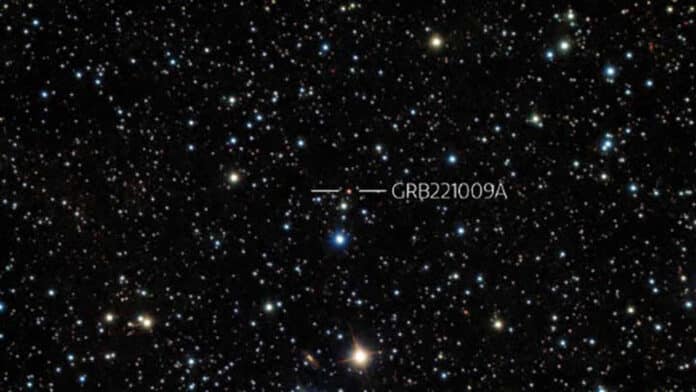Gamma-ray bursts come from random directions of the sky. The Gamma-ray Burst Monitor (GBM) is an instrument in low-Earth orbit aboard the Fermi Gamma-ray Space Telescope that can see the entire gamma-ray sky not blocked by the Earth and hunts for GRBs as part of its main program.
The University of Alabama in Huntsville (UAH) has announced that three researchers associated with the UAH Center for Space Plasma and Aeronomic Research (CSPAR) have discovered a gamma-ray burst (GRB) that ranks as the brightest ever observed. The GRB is found approximately 2.4 billion light-years away in the constellation Sagitta. It is believed to be triggered by a massive star’s collapse and a supernova explosion, forming a black hole.
Such extremely bright GRBs are expected to be seen only every 10,000 years or so.
Dr. Peter Veres, an assistant professor with CSPAR, said, “We routinely detect GRBs at a rate of about five per week and keep an eye out if any of the GRBs are special in some way. This one was so bright the instrument couldn’t keep up with many incoming photons. Most of the work, led by Stephen Lesage, was to figure out how to reconstruct the lost counts.”
The GBM has two detectors composed of bismuth germanate for high-energy gamma rays and 12 sodium iodide detectors for X-rays and low-energy gamma rays. Gamma rays that enter these detectors interact with the instrument’s crystals. The amount of light produced increases with the gamma ray’s energy. The GBM can determine the direction of the bursts by observing which crystals light up. Over 3,500 GRBs have been found by the Fermi instrument in total, and 221009A is by far the brightest.
Dr. Veres explains, “During a GRB, we see the death of a massive star, approximately 30 times more massive than the Sun, and the formation of a black hole. The black hole launches a high-speed jet close to the speed of light, and the jet will produce a gamma-ray burst. At later times, GRBs are visible at other wavelengths, from radio or optical through very high-energy gamma-rays, which is called the afterglow of the GRB. This GRB was so bright, the afterglow showed up in the Gamma-ray Burst Monitor, which is very uncommon, and we could follow it for almost three hours.”
Journal Reference:
- S. Lesage et al., Fermi-GBM Discovery of GRB 221009A: An Extraordinarily Bright GRB from Onset to Afterglow, arXiv (2023). DOI: 10.48550/arxiv.2303.14172
